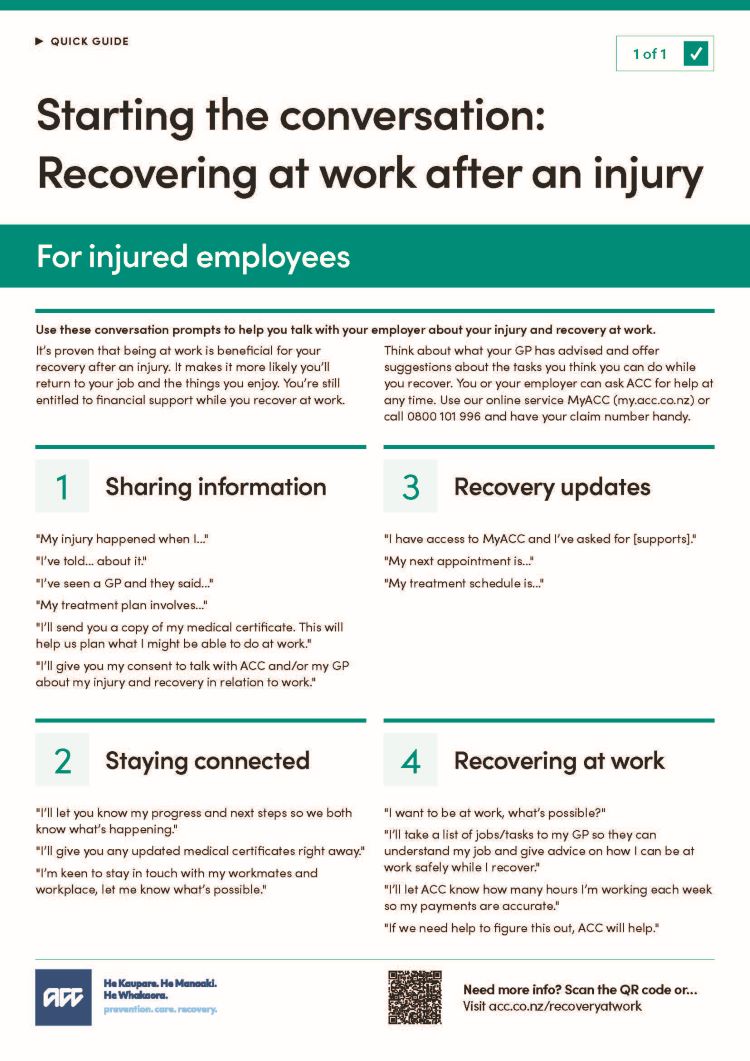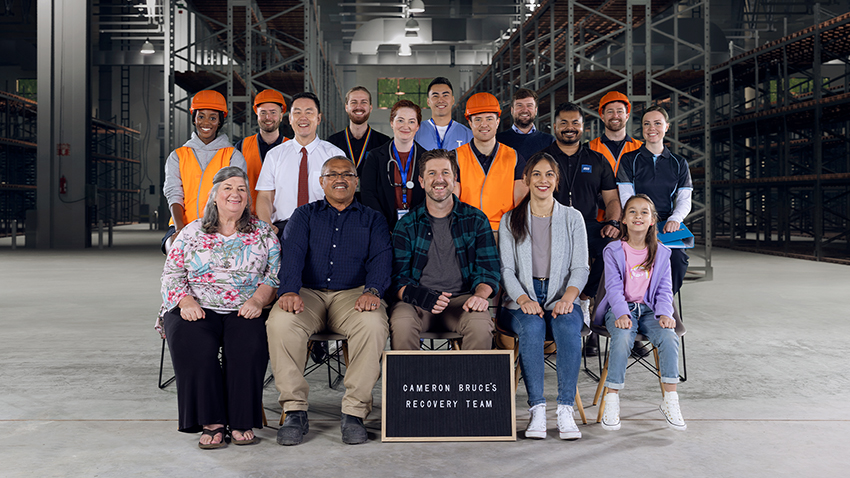Your recovery at work guide
Recovering at work after an injury can help people get better, sooner. Most people with non-complex injuries, like a sprain or a strain, can recover safely at work. You might need to make some temporary adjustments.
Here's your guide to the recovery and support available to help you get back to work.
On this page

Download: Guide to help you talk with your employer
Do you need time off work after an injury and not sure what to do next? Talk to your employer about your injury and what your health provider has advised.
Download and use this handy conversation guide. It gives ideas on what to say to your employer and how you can work together while you recover.
Start your recovery journey
Recovery at work takes a team effort. Your employer, doctor, other health professionals and ACC all have a role to play in your recovery. Sharing what support you need will mean others can play their part in helping you recover.
To safely recover at work you might need to make some temporary adjustments, like doing slightly different duties than your normal job, or doing fewer hours. It could also mean working with modifications or in a different environment.
-
Visit your health provider to get treatment
This could be at your doctor, physiotherapist, an after hours medical centre or the hospital emergency department.
Learn what to do if you're injured -
Start the conversation with your employer
Use the conversation prompts in this handy quick guide to help you talk with your employer about your injury and recovery at work.
Conversation guide for injured employees -
Register for MyACC
MyACC lets you manage your injury, support, and recovery online. It allows you to get the help you need from us quickly and easily.
Learn more and register for MyACC -
Apply for weekly compensation
You could earn up to 100% of your pre-injury income if you work while you recover, but that's not automatic - you’ll need to get set up for it online with MyACC.
Learn more and apply for weekly compensation -
Visit your GP before your medical certificate expires
This ensures any weekly compensation you are being paid continues. If you're set up for weekly compensation, you'll be able to upload new medical certificates yourself using MyACC. -
Keep the conversation open with your employer
It’s important you keep your employer informed of your injury and situation so that they can safely support your recovery at work.
Learn more about the role your employer, health provider and ACC play in your recovery
Watch: How to recover at work
Video transcript for How to recover at work
Text appears on a blue background.
‘How to recover at work’
We see Cameron sitting down with his hand and wrist in a black brace. He’s flexing his hand to check how it’s healing.
Narrator: If you’re injured and can’t work, that’s not ideal.
The camera zooms out and we can see that Cameron is in a large warehouse with a row of five chairs and a row of six stools behind them. His employer, Rua, walks in from the left and greets him with a fist pump and hug. He places a sign at his feet that says ‘Cameron Bruce’s Recovery Team’.
Narrator: But if you’re able to take on some light duties, or even help out part-time, there are real benefits in recovering at work.
Text appears:
Recovery at work helps you
- Return to your usual role
- Look after your physical and mental wellbeing.
Narrator: You’re much more likely to go back to your old role, and it’s better for your physical and mental wellbeing.
We see workmates with high-vis vests, healthcare providers, and whānau join the scene, greet Cameron and take a seat around him.
Narrator: But it takes a team and there’s a few steps you’ll need to go through first.
Text appears:
Get a medical certificate
Narrator: You’ll need to see a doctor or nurse practitioner for a medical certificate. This will give you and your employer an idea of what tasks you can take on.
Text appears:
Have a kōrero with your employer and make a recovery plan together.
Narrator: Then you can arrange a kōrero with your employer and make a recovery plan together. There’s more about how to do this on our website.
Text appears:
Register for MyACC to:
- apply for weekly compensation
- upload documents
- receive help with travel and equipment.
Narrator: Next, sign up to MyACC. There you can apply for weekly compensation and keep an eye on everything you’ll need to know, as well as upload any documents we may require. We may also be able to help with some travel costs and any special equipment you might need.
We see Cameron’s team taking their place around him, ready for their team photo. A photographer takes the team photo.
There’s a camera flash and then we see the team photo presented in a blue photo frame. Then we see the team getting ready to get back to work.
Narrator: And then you can concentrate on getting better and back to your usual mahi. Keep in touch with your employer and use the resources on our website, because teamwork makes recovery work.
Text appears:
Kia mahitahi, kia whakaora
Teamwork makes recovery work
We see the ACC logo.
Why recover at work
Evidence shows recovering at work after an injury helps people get better, sooner. With the right team in place to support you it also makes it more likely you'll return to your job and the things you enjoy outside of work.
Recovering at work can:
- improve physical and mental wellbeing by staying connected to your workplace
- increase independence and confidence
- lead to shorter recovery times
- mean earning up to 100% of your pre-injury income.
Watch: Ballerina Mayu's recovery at work story
Video transcript for Mayu's story
Audio: gentle music
Visual: Mayu Tanigaito, a ballet dancer wearing dark blue trackpants and t-shirt, puts on a pair of pointe shoes
Transcript: VOICE OF MAYU TANIGAITO
It was great to be able to recover at work while I was doing my rehab.
Visual: Mayu stretches in the studio whilst talking to two fellow Royal New Zealand dancers who are sitting on the floor
Audio: Connecting with work means connecting with those people.
You know, you feel like you're living your life still.
Visual: Mayu performs five pirouette turns then stretches her arms out to finish
Kia ora. My name is Mayu Tanigaito.
Visual: Mayu sits on a chair in the main studio of the Royal New Zealand Ballet, with large mirrors behind her
Audio: I'm Principal Dancer with the Royal New Zealand Ballet.
This is my 12th year with the company.
Visual: Mayu leaps across a sunlit studio wearing a white, classical tutu, with other similarly dressed female dancers in the background
Audio: I was trying to do this one big jump and taking off I felt like all the sudden, like a weird feeling in my knee.
Visual: Mayu performs on stage in the lead roles of Romeo and Juliet, and Giselle
Audio: That injury kind of reminded me how special to be on stage in front of the audience and sharing the feeling with the audience. I was trying to come back to dancing, but my body telling me stop dancing because it's just not right.
Visual: A lower leg shot of Mayu pointing and stretching her feet
TEXT ON SCREEN:
Mayu went on a Recovery at Work programme involving ACC, the RNZB and health providers, which allows people to do alternative duties while they recover from injury.
Visual: Mayu speaks to camera
Audio I went to our Royal New Zealand Ballet physio.
Visual: a diagram of a knee joint showing the anterior cruciate ligament
Audio I went to take MRI and then, you know, you can really clearly see ACL is gone.
Visual: Mayu speaks to camera
Audio ACL recovery has like a strict protocol to follow. So first six months, I'm not allowed to start dancing at all.
Because of my age too like I decided to take a little bit longer time.
Visual: Mayu working on her strength and flexibility in the studio
Audio: So, like, ACC gave me help to get into gyrotonics and Pilates. Try to get strength back, try to get flexibility back for that first six months.
Visual: Mayu looks out the large window of the studio
Audio So even though I'm not able to dance, company gave me to do some work.
Visual: Photos of Mayu with young dancers and doing exercises with residents of a retirement village
Audio For example, like a Ryman Healthcare visit. They were making a new programme for the older people to start moving their body and stuff like that. Yeah, that was really fun actually.
Visual: A man stands on the main studio of the Royal New Zealand Ballet and addresses the camera
VOICE OF DAVID MCALLISTER, ACTING ARTISTIC DIRECTOR, RNZB:
Audio: I think the most important thing for when you have a long term injury with the dancer in the company is you want to keep them involved in the organisation and also support them because it's not just a physical thing that they're dealing with.
It's a very emotional thing.
Visual: Mayu performing on a black and white contemporary ballet film
Audio: And, you know, one day you're jumping around with the rest of the company and the next day, you know, you could be by yourself in a gym doing squats or something like leg press.
So it's really important to maintain that relationship with the dancer
Visual: David speaks to camera
Audio: and for them to feel like the company hasn't moved on without them, that they are really still an integral part of the organisation.
Visual: Mayu performs ballet barre exercises in the studio
TEXT ON SCREEN:
Research shows that recovering at work can be good for a person's physical and mental wellbeing.
ACC can provide a rehabilitation programme, financial support, equipment and transport.
Visual: Mayu in studio tying her pointe shoes, stretches her feet and legs and talks to fellow dancers.
VOICE OF MAYU TANIGAITO
Audio: It was great to come to the company to start rehabbing soon as possible so that I can keep my routine, so I can have motivation. I can have like mentally: 'Yes, I want to come back dancing.' Yeah, everyone was like "Oh, I'm so excited for you to come back.” They're like giving me so much positive energy.
Visual: Mayu speaks to camera
Audio: So I definitely needed that. If I had to stay at home, have to do rehab by myself that's too difficult.
Visual: Dancers in over-the-top wigs and make up clink champagne glasses as Mayu rushes past them and hits one with a balloon.
Audio: Before, I never thought about it, but like now I'm like, this might be my last (time on) stage.
Visual: Mayu dancing various roles on stage
Audio: So, like, I'm just going to enjoy it and try to put everything out there to share with the audience and just really enjoy that moment.
Visual: Mayu speaks to camera
Audio: Yeah, that's probably one thing that's changed.
WHITE TEXT ON BLUE SCREEN:
Recovery at Work takes a team effort – from the injured person, their employer, and their health provider, as well as their whānau and workmates. Learn more about what role you can play in recovery at work at acc.co.nz
Teamwork makes recovery work
With special thanks to the RNZB
ACC and RNZB logos
After suffering a ruptured Anterior Cruciate Ligament (ACL), Mayu Tanigaito's career as one of New Zealand's leading ballet dancers was in limbo. But with the support of the Royal New Zealand Ballet and ACC, she was able to get back to her best.
